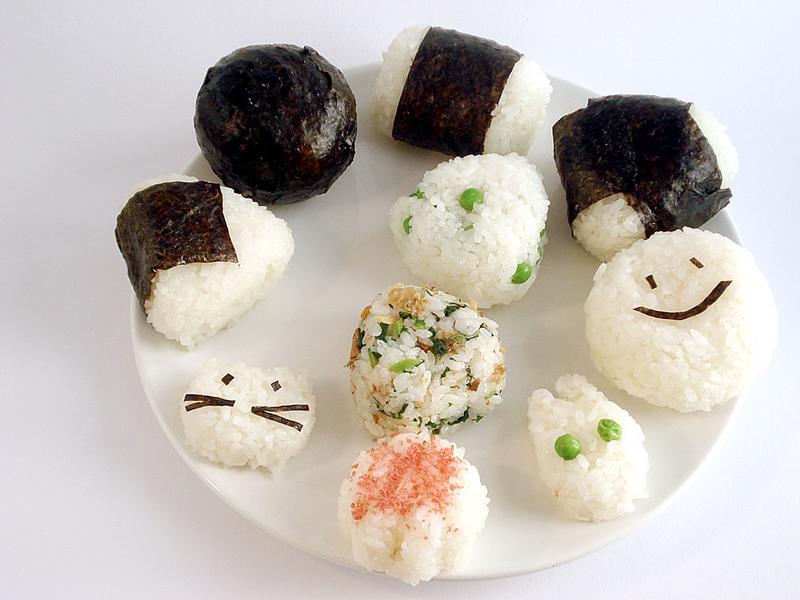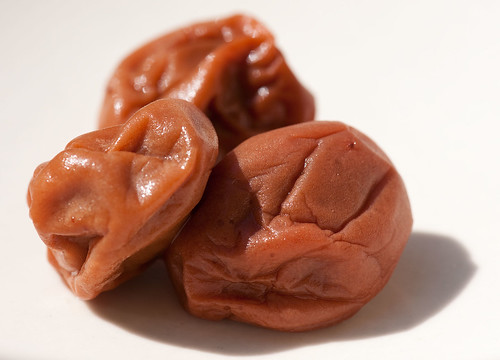Onigiri On Parade: A guide to onigiri (omusubi) rice ball shapes, types and fun
[Update:] Also check out the Onigiri (omusubi) FAQ!
Onigiri (or omusubi, the other name for the same thing), the cute little rice ball, has really become popular outside of Japan in the last few years, in large part it seems due to its iconic status in anime and manga. While the onigiri is not limited in Japanese food culture to just bento use, it's an indispensable part of the bento maker's repertoire.
Previously on Just Hungry, I've explained how to make onigiri twice: the traditional, hot salty palms way, and an easier method using plastic wrap and a cup. And you can always use a plastic onigiri mold if neither method appeals. However, I have never really gone into depth about the different shapes and kinds of onigiri. So, here it is - a parade of different kinds of onigiri: shapes, coverings, fillings, and more.
But first to dispell some onigiri myths...
- Onigiri do not have to be triangular in shape.
- Onigiri do not have to be covered with nori seaweed.
- Onigiri do not have to have a filling.
- If the rice is sushi rice (flavored with sushi vinegar), it is no longer onigiri, it's sushi.
The one rule of onigiri is...
Onigiri must be made with sticky, short- or medium-grain rice, ideally steam-cooked japonica type rice. If you can't get a hold of Japanese rice (also commonly sold as 'susi rice'), Italian medium-grain rices uses for risotto like vialone (which is the most like Japanese urichi-mai), arborio and so on can be used. Long grain type rice just will not stick together sufficiently. See the Looking at Rice article for an in-depth explanation of different types of rice, and what can and cannot be used successfully for onigiri.
(Note that I've used white rice for illustration purposes for this article, but properly cooked brown rice can be used in most cases too.)
The keys to great tasting onigiri are
- Good rice, properly washed and cooked. There is a big difference between mediocre rice and good rice
- Sufficient salt to flavor the onigiri - either on the outside if making the usual type of onigiri, or with a salty filling inside, or salty enough sprinkles.
Traditional onigiri shapes
As stated above, an onigiri does not have to be triangular. As long as it holds together, it can be any shape possible.
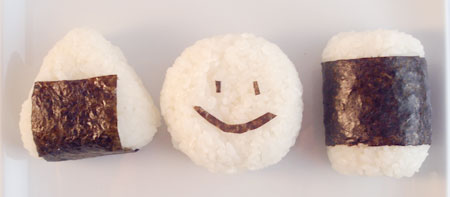
Above are the the traditional hand-formed onigiri shapes: triangle, flattened round, and cylinder or tawara. Tawara is the shape of the traditional straw bale that was for storing and transporting rice.
Type 1: The plain, unadorned, unfilled onigiri
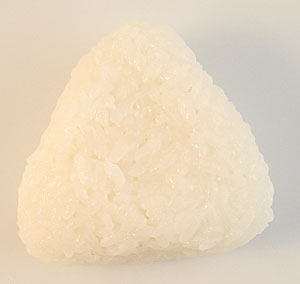 This is a plain ball of rice, lightly salted on the outside. There is no filling, nor any cover. If one has excellent quality rice, such as top class shinmai (new rice from the current harvest) and wants to savor the pure flavor of the rice, this is the one to have.
This is a plain ball of rice, lightly salted on the outside. There is no filling, nor any cover. If one has excellent quality rice, such as top class shinmai (new rice from the current harvest) and wants to savor the pure flavor of the rice, this is the one to have.
A plain onigiri like this is the essence of Japanese food to me: rice, and salt. Rice was so important that the wealth of lords used to be measured in how much rice their lands produced, and salt is used extensively in Shinto rituals even now, to purify and sanctify. The onigiri as religious icon? Why not?
Type 2: The filled, nori covered onigiri
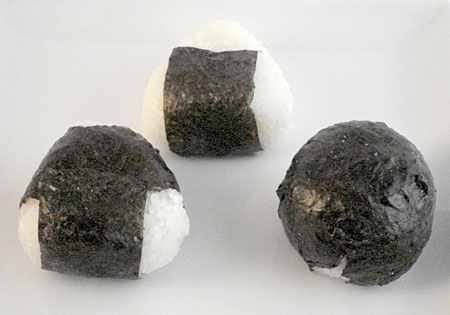
This is the most popular kind of onigiri, with a small amount of salty filling in the inside covered with plain rice, which is covered partly or fully with nori. Depending on if you like your nori crispy or a bit soft and moist, you either carry the nori separately and wrap it around the rice when eating, or put it on the rice when making (and when the rice is still warm). Since it's like thin paper, it can be cut easily with scissors, and is used quite a lot for decorative 'cute' bento.
Type 3: The sprinkled onigiri
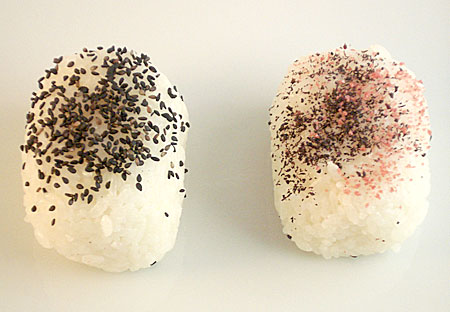
This is a filled or unfilled onigiri that is sprinkled on the outside with something. Sesame seeds, gomashio (sesame seeds mixed with salt), or furikake (mixed savory sprinkles - there are many various flavors) are commonly used. The one on the left is sprinkled with gomashio, and the one on the right with two colors of yukari (dried shiso leaf powder).
Type 4: The mixed-rice onigiri
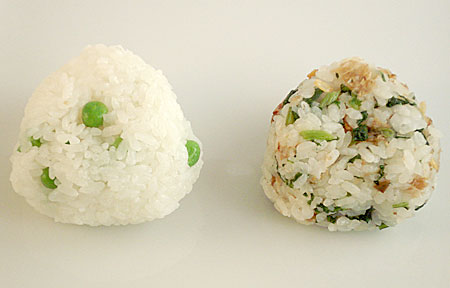
For this type of onigiri, the rice is first mixed with something, then formed into a ball. The example above on the left is mixed with green peas, and the one on the right is mixed with homemade furikake made from radish leaves and bonito flakes (recipe ). Since the rice is flavored, this type usually doesn't have a filling, and is often not covered to show the rice off (or just has a minimal nori strip). Anything can be mixed into the rice like this as long as it's not too moist or oily, which will make the rice grains fall apart.
Type 5: The visible-inside onigiri
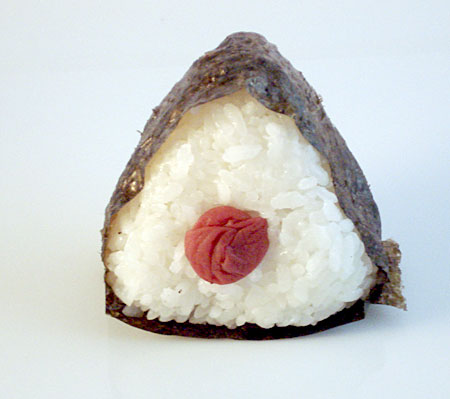
This type of onigiri shows off the inside and is only wrapped around the sides, rather than all around the ball. This one is rather more difficult to make than other types.
Type 6: Onigiri with alternate wrappings
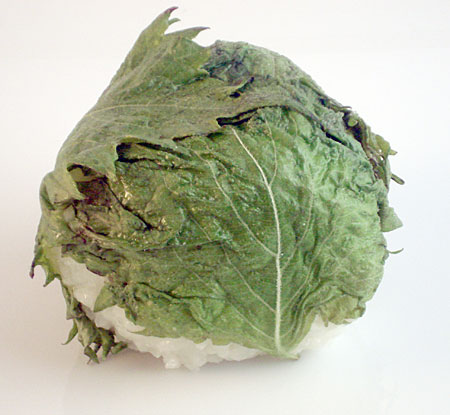
Nori is the most common onigiri wrapping, but there are other wrappings. Here is one wrapped in salted green shiso leaves.
Other wrappings include nozawana zuke (pickled green leaves) and hakusai zuke (pickled nappa cabbage), thin dried kombu seaweed called tororo, and so on. I've even seen salted lettuce leaves and kimchee used as wrappers. Onigiri wrapped with alternate wrappers can be filled or unfilled, depending on how salty the wrapping is.
Type 7: Yaki Onigiri - grilled onigiri
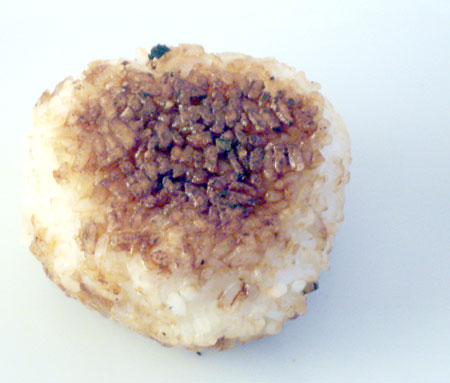
Onigiri that is grilled on a wire grill until crispy, then brushed with soy sauce or miso. Yaki onigiri are best served hot, though they can be chewy yet tasty bento additions. Yaki onigiri usually do not have fillings, though some people like to put a little umeboshi or okaka inside (see the Filling section below).
What goes inside the onigiri
 In response to my previous onigiri posts on Just Hungry, the question asked the most is about fillings. I have already written about this before, but it bears repeating here. Basically, anything that fits with rice and is not too greasy or watery can be used as filling. So, if the traditional fillings don't appeal to you, try things that you like and see how they taste!
In response to my previous onigiri posts on Just Hungry, the question asked the most is about fillings. I have already written about this before, but it bears repeating here. Basically, anything that fits with rice and is not too greasy or watery can be used as filling. So, if the traditional fillings don't appeal to you, try things that you like and see how they taste!
If you are a traditionalist as I tend to be, here are the most popular fillings.
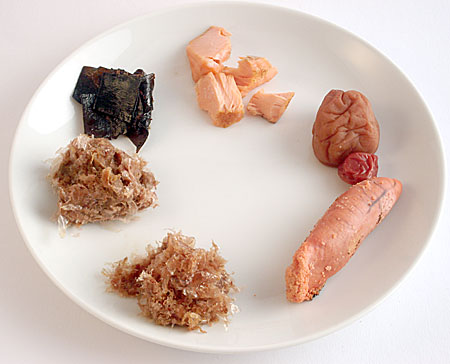
From the top, clockwise:
- Shiozake or shiojake, salted salmon which is grilled and flaked. It's easy to make your own.
- Umeboshi (salty pickled plum). A little of this goes a long way. It also has some antibacterial qualities, so it's the ideal filling for onigiri that might be travelling at room temperature for some time. The photo shows regular soft umeboshi Not shown here is the crunchy and smooth skinned kariume.
- Tarako, salty cod roe that is cooked and cut into small chunks. (While tarako is closely related to mentaiko, spicy cod roe, you don't see mentaiko used as an onigiri filling that often for some reason, but it's equally good as an onigiri filling.)
- Okaka is bonito flakes or katsuobushi (the kind used for making dashi stock) mixed until moistened with soy sauce. (Confusingly it's also just called katsuobushi or katsubushi.) You must take care not to mix in too much soy sauce, or it will seep through the rice and cause the onigiri to crumble.
- Umekaka, bonito flakes mixed with umeboshi.
- Kombu no tsukudani or shio kombu - kombu seaweed that's been cooked in a soy sauce based sauce until tender and salty. Other types of tsukudani can be used too. How to make your own _kombu no tsukudani_.
Rather less traditional but widely popular:
- Tempura - shrimp tempura (shrimp fried in a light batter) used either as a filling or on the outside. This type of onigiri is called tenmusu. It's a regional speciality of the city of Nagoya.
- Canned flaked tuna mixed with mayonnaise - the tuna is almost always oil-packed. This filling doesn't keep that well - eat within a few hours.
- A piece of chicken karaage (fried chicken).
- Various kinds of chopped up pickles
Fun with onigiri
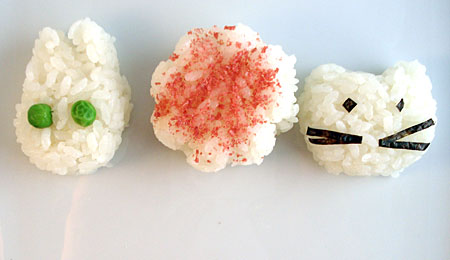
If you use molds you can make other shapes too, such as these above. Why not a bunny or cat onigiri? Personally I don't use molds much since I can make them by hand a lot faster, but they can be fun if you have the time, or are making them for a party or something like that. (I actually used egg molds to make the ones in the photo.) Faces can be made with cut nori or anything you can imagine. It should all be edible though!
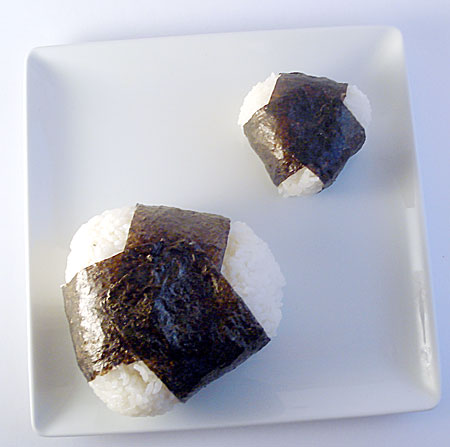
You can also play around with the size of the onigiri. Here's a 'jumbo onigiri' side by side with a regular sized onigiri. The Jumbo has three kinds of fillings inside,has about 2 1/2 cups of rice, and comes in at around 600 calories. It's a two-fisted onigiri!
Eater beware, or the calories in onigiri
A small to average sized onigiri has around 1/3 to 1/2 cup of rice, which is 80-110 calories. Depending on how big you make them they could be even more. If you are doing portion control, it's best to pre-measure the amount of rice as in this method.
Freezing and keeping onigiri
Onigiri can be frozen, well wrapped and filled (except for tempura and chicken karaage type fried fillings, which can get soggy or tough if you microwave them later). I would not make onigiri with frozen rice however - it's best to form the onigiri an then freeze it. You can then de-frost them, still wrapped, at room temperature, in the fridge or gently defrosted in the microwave. See also: Keeping onigiri fresh and more.
Combined with the previous onigiri articles linked to here, I hope that this answers most, if not all, of the onigiri questions you may have. (Except for the famous Hawaiian Spam Musubi. I still haven't tried it. Anyone want to invite me to Hawaii? ^_^) (Since this article was originally posted, I've been to Hawaii, and tried spam musubi several times. I found them edible but do not love them. Sorry, spam musubi fans!)
[Edit:] This post is Bento Of the Week on Yum Sugar. Thanks to Team Sugar!
Before asking a general question about onigiri, please check out the Onigiri FAQ page. Chances are your answer is already there!
If you enjoyed this article, please consider supporting this site by becoming my patron via Patreon.
Quick onigiri tip: Show what's inside on the outside
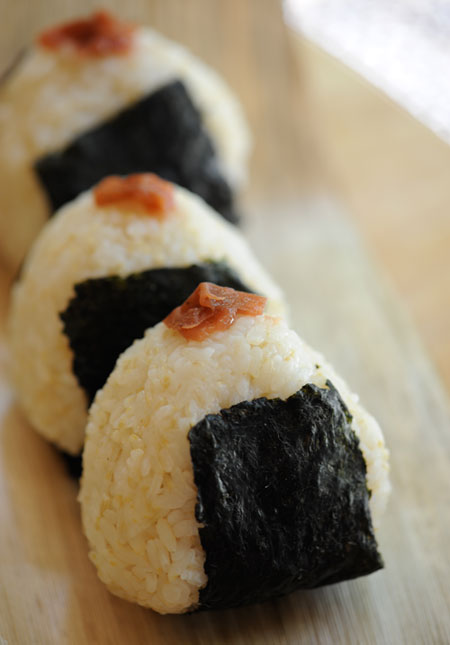
Here's an ultra-quick tip from a Japanese magazine. Sometimes I make a lot of onigiri, for a picnic or a party for example. I usually like to stick to the basics and wrap them in nori seaweed. The problem with that is that they all look the same from the outside, so the only way to identify what a particular onigiri's filling is to crack it open slightly! That can get a bit messy.
The 'why didn't I think of that' simple solution: Just put a tiny amount of the filling on top of the onigiri, as I've done in the photo. Not only does it show what's inside, it makes the first bite into the onigiri that much more tasty. I think it also looks rather cute!
For these onigiri, I used brown rice, and my mother's homemade umeboshi, which she brought along all the way from Japan. Beautiful, aren't they?
Check out her recipe for making umeboshi over on Just Hungry!
If you enjoyed this article, please consider supporting this site by becoming my patron via Patreon.
The Onigiri (Omusubi) FAQ
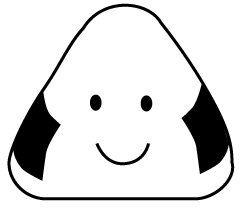 I have written quite exhaustively about onigiri, or rice balls, here on Just Bento as well as on Just Hungry. Many people have asked similar questions about onigiri, which seem to just be gaining and gaining in popularity these days. So I've assembled a list of Onigiri FAQs (Frequently Asked Questions). I'll update this list when I see (or remember) other questions periodically.
I have written quite exhaustively about onigiri, or rice balls, here on Just Bento as well as on Just Hungry. Many people have asked similar questions about onigiri, which seem to just be gaining and gaining in popularity these days. So I've assembled a list of Onigiri FAQs (Frequently Asked Questions). I'll update this list when I see (or remember) other questions periodically.
Basics and culture
- What is an onigiri? An onigiri is a savory (salty) compressed ball of rice. It often has a filling or a coating of something savory, but there are also onigiri made of pre-flavored/mixed rice, as well as plain rice onigiri simply made with salt.
- How do you pronounce it? o-NI-gi-ri (short 0 at the top, not oh or ooh)
- How is it written in Japanese? most often おにぎり (all in hiragana); very occasionally お握り
- My Japanese friend/my Japanese grandmother/my Hawaiian uncle calls it something else... Onigiri are also often called omusubi (おむすび). Some more obscure regional names include nigirimama and oninko. You can also drop the honorific o and call it musubi, nigiri, or nigirimeshi (which literally means "hand-pressed rice". What you call it just depends on where you grew up! In Hawaii, a rice ball is called a musubi mostly. There was a big wave of emigration from Japan to Hawaii in the late 19th century, mainly from the western/southern parts of the country, which probably accounts for the use of musubi.
- Why do anime and manga characters love onigiri so much? Onigiri is Japanese comfort food, because Japanese people love rice. Rice is the main staple of Japanese cuisine. (In the movie Kamome Diner (kamome shokudo), discussed at length here, onigiri are called "Japanese soul food", and I think that is very true.)
- Does an onigiri have to be a triangle? No it doesn't - it can be round, or cylinder shaped, or anything else. There are a few purists who insist that onigiri must be triangular, but I'm not one of them. See Onigiri on parade.
- Where can I get onigiri in Japan? Just about every supermarket and convenience store sells them, not to mention train station kiosks, vending machines and more. They are as common as pre-made sandwiches are in the West. (Actually you can get pre-made sandwiches as easily too in Japan.)
- Are onigiri just for bentos? In Japan, onigiri is a basic convenience food. People carry them on hikes, car trips, have them for breakfast, as late night snacks...etc.
- Are onigiri a Japanese invention? They probably are, because of the nature of Japanese style rice (slightly sticky). This type of rice, also called uruchimai, came into wide use around the 11th or 12th centuries, and onigiri may have come into existence then. In China you have steamed glutinous rice wrapped in leaves, but that's a bit different from onigiri. (see okowa onigiri made from sticky rice)
- Is Spam Musubi Japanese? Spam musubi is a product of Hawai; it was probably created by immigrants of Japanese descent. Spam was virtually unknown until fairly recently in much of mainland Japan. (Spam is fairly popular in Okinawa, which was occupied until the 1970s by the United States and still has a U.S. military base. It's also very popular in South Korea. Both regions, as far as I can find out, got their Spam habit from Americans.) Personally, I just can't make myself like Spam in any form, so you won't see any spam musubi recipes on this site - sorry! There are plenty of spam musubi recipes online however - see this one on Lunch In A Box, or this step by step on Cooking Cute.
Nutrition
- How many calories are in an onigiri? It depends on how big it is or how much rice is used to make it. A typical onigiri has about 1/2 cup of rice, so it's around 100 calories plus whatever is used for the filling.
- Does an onigiri have to be made with white rice? You can also make it with brown rice, as long as it's medium-grain Japonica rice or short-grain glutionous rice. See Looking at rice.
- Are onigiri diet food? Well, that depends on how big they are! Many people find onigiri more filling than sandwiches, but that's a subjective thing of course.
How to make onigiri
- What's the key to making good onigiri? The base ingredient of onigiri is the correct type of rice, cooked properly. A rice cooker can be very helpful for doing this. See how to wash and cook rice properly using a rice cooker or on the stove, and more about rice cookers.
- Do I have to use Japanese rice? What about jasmine rice (or other types of rice)? An onigiri has to stay in a ball shape, so the rice has to be glutinous enough that the grains stick together. That means that long grain rice types like jasmine and basmati are not, I repeat not, suited to onigiri. (I feel very strongly about this.) Sure, mushy, overcooked rice will glue together if you mash it hard enough, but it will not taste nice at all. The most suitable types of rice for onigiri are medium grain or short grain. See Looking at rice for different types of rice. If you can't get Japanese type rice (or 'sushi' rice) easily where you live, Italian rices used for risotto can be substituted.
- How do I make onigiri? There are very detailed instructions for how to make them with your bare hands, plus an easier way using plastic wrap. JustBento reader Samantha contributed this great method of making onigiri in a plastic bag, using the corners! You can also use handy molds/moulds: Cooking Cute has a nice step by step tutorial. Recent onigiri molds come in a handy scooper shape which makes making onigiri in all kinds of cute shapes even easier. Example: these Hello Kitty molds, and the colorful mini onigiri I made with them.

- Does an onigiri have to have a filling? No it doesn't! The most basic type of onigiri is a shio musubi (塩むすび), a plain rice onigiri with salt on the outside. This is the kind of onigiri that was carried around in feudal times by samurai and foot soldiers on the warpath. It's a great way to enjoy simple, well cooked good rice.
- What are traditional onigiri fillings? A list and photos of the most common traditional fillings are on the Onigiri on Parade page. The top three traditional fillings are: umeboshi (pickled plums), shake (salted salmon - how to make your own from fresh salmon) and okaka (katsuobushi or bonito flakes flavored with soy sauce).
- Non-traditional fillings? Anything you can imagine! Some suggestions that readers have made in the past include: chopped up olives, anchovies, pickles, a small meatball, cooked chicken, sausage meat, chopped up Spam, corned beef... as long as it's not too wet, compact and a bit salty, anything can be a good onigiri filling.
- Help! My onigiri fall apart! This could either be due to using the wrong kind of rice (long grain rice, jasmine rice, basmati rice, etc. are not sticky enough to make a rice ball with), improper cooking of rice (it should not be too dry/hard OR too sticky/gluey) or using a filling that's so oily or watery that the oil/water seeps out into the rice, making it fall apart.
- Do onigiri have to be wrapped in nori seaweed? No they don't, though a wrapping does help to keep the rice together. Again see Onigiri on parade. If you want to go wrapping-less but your onigiri falls apart before you can eat it, try transporting them wrapped in plastic wrap. You can even buy special cute onigiri wrapping film!
- I hate nori...alternative wrappers? A popular wrapper is salted fresh shiso leaves. (I must confess that when I was a kid, I hated nori! But now as an adult I love it, so it is quite possibly an acquired taste.) Other wrappers include tororo kombu (a thin, salty form of kombu seaweed) and usuyaki tamago (thin omelettes).
Onigiri safety and transport
- Can I freeze onigiri, and if so how? Yes onigiri can be frozen very successfully. Just wrap them individually in plastic wrap (cling film), and then in a freezer box or bag to protect it from freezer burn. You can defrost the onigiri in the refrigerator gradually, at room temperature, or zap it in the microwave. See Keeping onigiri fresh and more Don't keep frozen onigiri in the freezer for too long, or they will eventually get freezer burn.
- How do I prevent onigiri from getting dried out? Keep them well covered/wrapped up.
- How long do onigiri last in the refrigerator? How do you keep them safe to eat? This mainly depends on the filling as well as how much salt you use on the surface when you make the onigiri. If you use tuna with mayonnaise or any filling with mayonnaise in it, do not keep more than a day to be safe. If you use traditional fillings, especially umeboshi (pickled salty plums) they will last a lot longer, but no more than a couple of days. Umeboshi has natural antibacterial qualities, so is the ideal filling for onigiri that have to be held for some time - say, made the evening before to be eating or lunch on the road the next day.
In any case, you should make onigiri with adequate salt on the outside, completely cooked fillings (never ever use raw/uncured fish or rare meat) and always use freshly cooked (ideal) or defrosted/reheated rice. If the weather is very warm and humid and you have used spoilable fillings such as tuna/mayo, consider packing your onigiri with an icepack (see Summer Bento Safety).
You shouldn't eat onigiri that has been around outside of proper refrigeration for more than a day. Anecdotally, I have eaten onigiri that was a day old (made the morning before and eaten for breakfast) that had been in packed in a paper back and thrown on the back seat of a car, not in a cooler, and survived without any problems (it was in the fall, not midsummer), but you shouldn't do this regularly! The fillings used that time were umeboshi and salty salmon, for what it's worth - no tuna-mayo or crab salad or other highly perishable filling.
(I've seen a note on this ehow.com page that blithely states that "you can store onigiri refrigerated for up to a week". No you can not! Please, use common sense and be safe not sorry. )
Other questions
- Can I use sweet fillings for onigiri? Fundamentally you can use anything you like - it's your food! However, in Japan if you make a ball of rice (which is often sweetened itself, and pounded partly or fully to a sticky paste or dough) and filled with something sweet it becomes confectionery or __wagashi__. Some wagashi that take the rice-with-sweet-filling form include daifuku, mochi of various kinds, _yatsuhashi_ and so on. The wagashi that's closest to the idea of a sweet onigiri is probably _ohagi_ or _botamochi_, glutinous rice "onigiri" of sorts which are filled, covered or both with sweet bean paste, kinako (toasted soy bean powder), sesame seeds and so on. So, to Japanese sensibilities an onigiri is something savory, not sweet.
- What's the difference between sushi and onigiri? Again it's a matter of how things are normally categorized in Japanese cooking, but generally speaking anything made with vinegar flavored rice, or sushi rice (sushi meshi or shari) iis sushi. So you could make an onigiri-shaped item with shari, and call it an onigiri, but if a Japanese person ate it s/he would probably think it's sushi in an onigiri shape. Nigiri-zushi, the best known sushi shape with a little ball of rice topped with fish or something else, is sushi that has been shaped with the hands (nigiru) - the same word that forms part of the word onigiri.
See Also
- How to make onigiri the basic traditional way
- How to make onigiri with plastic wrap - easier for beginners!
- How to make onigiri in a plastic bag
- How to make onigiri using a basic mold (on Cooking Cute)
- Onigiri On Parade: A guide to onigiri types, shapes, types and fun
- Onigiri in the movies - two Japanese movies that feature onigiri prominently (Supermarket Woman and Kamome Diner). By the way, in Kamome Diner there is a scene where the owner of the Kamome Diner (a small Japanese cafe-restaurant she opens in Helsinki of all places) and her new friends are testing out alternative fillings for onigiri that they think may be more to the taste of Finnish people. They test things like crayfish, reindeer meat, pickled herring, and so on. But ultimately they come to the conclusion that the best fillings are the classics, the Big Three traditional fillings mentioned above: umeboshi, shake and okaka. I have to say I tend to agree with this (though I might add grilled tarako to the list too)!
If you enjoyed this article, please consider supporting this site by becoming my patron via Patreon.
